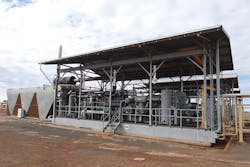Considerations for reciprocating compressors for processing units
Reciprocating compressors are important pieces of machinery widely used in processing facilities. This article discuses key points and areas of concern when it comes to these compressors such as operation, reliability, capacity control, vibration and noise.
A reciprocating compressor includes cylinders and pistons. A cylinder is closed at one end by the cylinder head and by a movable piston at the other. Cylinder valves sit at the base of the valve pockets. During the expansion phase, gas enters the cylinder through the suction valve when the piston moves and creates a vacuum. Then the piston reverses its direction of motion and starts to compress the gas. When the pressure in the cylinder exceeds the pressure in the discharge piping, the discharge valves open and the gas is pushed out of the cylinder. At the upper dead point, only a narrow gap between the piston and the cylinder head is left.
Major concerns
The operation of reciprocating compressors may seem simple. However, complex phenomena are associated with these machines. During compression, the pressure distribution in the cylinder is almost uniform, but when the pressure valve opens, a rarefaction wave is initiated, which travels back and forth in the compression chamber. Unwanted effects of these waves are oscillating moments on the piston, increased valve losses and decreased compressor efficiency.
Based on these unwanted effects, pulsation, valve operation and dynamic behaviors can pose major concerns for reciprocating compressors. Cylinder valves should be operated at each cycle. These values experience considerable dynamic loading and fatigue stress. The cyclic operation of a reciprocating compressor generates pulsation, which will be transferred to suction and discharge systems. Dynamic effects such as unbalance, movements caused by reciprocating action, waves (such as rarefaction waves), and many more effects should be considered for reciprocating compressors.
Capacity control
The capacity control is often determined by the compressor discharge pressure. Compressor capacity-control methods are utilized to maintain a required compressed gas delivery under variable process conditions. The main capacity control methods for reciprocating compressors are variable-speed drives, suction valve unloaders, step-less methods, clearance pockets and bypass recycling. The two main reasons why a reciprocating compressor capacity regulation is used are to adjust the suction mass-flow to match the process demand and to save energy.
Variable-speed reciprocating compressors are attractive, theoretically. However, they have many practical, technical and cost limitations. The minimum speed — because of some limitations in the compressor frame or variable speed drive (VSD) electric motor system — might not be sufficient for the necessary reduction in the volume flow.
The method based on suction valve unloader is a preferred capacity control method on multistage reciprocating compressors if the speed variation is not possible or sufficient to achieve the required part-load range.
Capacity control using suction valve unloading in its simplest form is carried out via an unloader system, which keeps the suction valve open and lets the gas return to the suction. In other words, suction valve unloaders are mechanisms that are held open or bypass suction valves of cylinders (mostly at each end of double-acting cylinders). This provides complete unloading of one or both ends of the cylinder. For a single-cylinder (double-acting) compressor stage, suction valve unloaders can achieve three-step loading that provides nominal cylinder capacities of 0, 50 and 100 percent. Thus, considering two (double-acting) cylinders per stage, the capacity can be controlled theoretically in five stages — 0 , 25, 50, 75 and 100 percent. In many compressors, 25 percent load is deleted because of reliability issues it might cause.
For a typical reciprocating compressor, three-suction valve unloader types are usually available: finger, plug and port. A finger unloader is not recommended when other types are viable. Plug unloaders should be installed on extra suction ports; they cannot be employed for small sizes — as a rough indication, valves below 80 millimeters (mm) in diameter. In general, minimize the number of suction valve unloader steps to maximize compressor reliability.
Unloaders are usually pneumatically operated by instrument air and equipped with positioner indication. The unloader actuator should be sized to operate on minimum air pressure. All lines to and from unloaders should be fabricated from a proper grade of stainless steel (usually stainless steel 316) to prevent issues that could potentially damage the entire compressor package.
Step-less capacity control systems
Another option is a step-less capacity control using a sophisticated control system combined with suction valve unloaders. The suction valve unloader, which acts against the closing of the valve components, can be adjusted to control the volume of gas that will be compressed in each cycle. In each compression cycle, the suction valve closes at a specific point that the step-less system calculated; therefore, the intake of gas is reduced to a desired flow. This results in a step-less capacity control system. This is a controlled and precisely actuated suction valve unloader system. There is a set of complex arrangements of control and hydraulic systems to manage such a step-less operation. However, overall a step-less capacity control method can offer reasonable part-load efficiencies whereas it adjusts the flow in the range of about 15 to 100 percent of the nominal flow in a step-less fashion.
Such step-less capacity control systems have been hydraulically operated and electronically controlled. Hydraulic actuators are needed because pneumatic systems used in old-fashioned and traditional suction unloading systems cannot offer the required precision and rigidity. These modern systems are expensive and have been used in medium or large compressors where a step-less, fast-response capacity control is required. The suction valve unloader will be actuated by a hydraulic actuator, which in turn is controlled by a set of solenoid valves. The control signal is generated in an electronic unit that receives its information from different sensors. For instance, the system receives information about the actual position of the piston from a top dead-center sensor and of the mass flow requirement from the process control system. The advantages of this combined control system lie in the fast response and the freely programmable reaction of the movement of the suction valve unloaders. This system can coordinate the control of all regulated suction valves, and at part-load the inter-stage pressures can be kept at the desired levels. This control can also be used for unloaded startup to reduce the load on the electric motor driver.
Other methods of capacity control
Clearance volumes as a capacity control method were popular many years ago. Today, they are only used in special cases where other capacity control options are not suitable or possible. The variable volume clearance pockets in particular have resulted in many operational and reliability issues and should be avoided. In these systems, the adjustable volume flow was controlled by the movement of a hydraulically positioned piston, which altered the size of the clearance volume. Manual versions of this system were used in some old-fashioned, small reciprocating compressors in which some cases actuator failures were reported. In other cases, the variable volume clearance pockets failed to operate because of weak and problematic clearance pockets (whether automatic or manual versions) and intermittent operation that led to operational problems and damage.
Fixed volume clearance pockets might be used in compressors in which one cylinder per stage is used and there is no opportunity to use variable-speed or other superior capacity control methods to achieve the required part-load operation. Such a capacity control method works by connecting the working chamber with an additional clearance pocket and thereby reducing the volume flow by reducing the volumetric efficiency. This type of control reduces the volume flow while reducing the energy input within some acceptable limits. The additional clearance pocket is usually fitted on the head-end side of a double-acting cylinder. A traditional option not suitable for modern machines was an external pocket that was connected by an external piping to the crank-end side chamber. This system is no longer used because of inherent weaknesses and poor historic operational records.
Opening the clearance pocket reduces the cylinder’s inlet volumetric flow by trapping additional gas in the larger clearance volume at the end of the piston stroke. Clearance-pocket flow adjustment is frequently applied to the head-end only, leading to about 50 percent reduction in the head-end capacity and a 25 to 30 percent overall capacity reduction in a double-acting cylinder. Suction valve unloaders combined with a fixed clearance pocket can provide five-step unloading leading to nominal cylinder capacities of 0, approximately 25, 50, approximately 75 and 100 percent in a compressor stage with only one cylinder (double-acting). At compression ratios below about 1.7, the pocket volume becomes very large relative to cylinder size, thus, it should not be used in such ranges.
Bypass control (or recycle control) uses an external bypass around the compressor to recycle gas from the compressor discharge to the inlet. The takeoff point for the bypass should preferably be the downstream of the discharge cooler so that cooled gas will be spilled back to the suction. Alternatively, if there is no cooler in the discharge, the bypass should branch into the suction line upstream of a heat exchanger (or a cooler). Bypass control is inefficient. However, for transient, short-time or fine-adjustment, it is preferred over other control methods because of its smoothness and simplicity. This method is commonly accompanied by the use of suction valve unloaders or fixed clearance pockets, which reduce compressor capacity in discrete predetermined steps.
In a multistage reciprocating compressor, a reduction in the flow of the first stage can cause a drop of all inter-stage pressures (suction pressure to the next stage), and consequently lead to excessively high pressure ratios and discharge temperatures in subsequent stages. Moreover, this pressure shifting may cause an overload in the last stage. The minimum capacity that can be obtained depends on the number of compression stages. On the other hand, when more stages are used and each stage has relatively low pressure ratios, a better capacity control can be performed. The more stages used for a given overall compression ratio, the wider the achievable control range.
Vibration and noise
The vibration and generated noises at a reciprocating compressor result principally from the response of the mechanical system to the forces, movements, waves and pulsations that are occurring in the reciprocating compressor during operation at different operating conditions. Gas load forces are important loads on any reciprocating compressor. These forces act on the piston and stationary components usually at 1× (the compressor running speed) and at integer multiples of running speed (N×). They are generally significant up to about 10×. They mainly affect in the direction of the piston rod travel, where they should be often considered as 3D for accurate dynamic predictions. For large, slow-speed compressors (up to 500 rpm), gas forces are typically the largest contributor to piston rod and compressor frame load.
Inertial load forces are other sources of dynamic loads. These forces are caused by the acceleration of the reciprocating components (piston, piston rod and crosshead). These components represent a large amount of mass to be accelerated back and forth with each stroke. Inertial loads of 500 kilonewton (kN) (equivalent to 50 ton) or more are not uncommon with large compressors. Reciprocating and rotating mass unbalance forces are predominant at 1× and 2× compressor running speed, and are caused by asymmetrical crankshaft and imperfect manufacturing tolerances. They are usually smaller than inertial and gas load forces. Gas unbalance forces are other significant sources of problems and issues linked to pulsation levels. These are caused by pressure in the pulsation bottles and pulsation at the cylinder nozzle area and on piping connected to the compressor.
Allowable pulsation levels are major concerns. Although these pulsating forces are usually much smaller than the forces listed above, they can be destructive to piping and piping support systems if they happen to correspond to resonant frequencies for the structures. As a consequence of these factors, the extent of vibration is inherent with any reciprocating compressor and its response to all the applied forces and movements. This causes these machines, even when in good condition, to vibrate much more than a comparable rotating machine (such as a centrifugal compressor).
Vibration measurement and monitoring
Frame vibration frequencies typically include components below 20 hertz (Hz). Even for modern high-speed reciprocating compressors, these vibration frequencies are usually lower than what is expected on turbocompressors. For this reason, velocity transducers, with extended low frequency response, are usually better-suited than accelerometers for detecting an increase of rotation-related forces due to gas load or inertial loads, imbalance, foundation looseness and excessive rod load. However, the best recommendation is to use both velocity transducers and accelerometers for the vibration measurement of any reciprocating compressors. The preferred locations for the frame vibration transducer are on the side of the frame oriented in the direction of piston rod travel, on the centerline of the crankshaft and at a main bearing where dynamic load is transmitted. Magnitude for a filtered frame velocity signal is usually low — less than 6 millimeter per second (mm/s); however, at low frequencies, even small amplitudes of measured velocity may correspond to large amounts of displacement. Because vibration measurements should be used for the alarm and trip, 2 out of 3 (2oo3) arrangement should be used; therefore, multiple vibration measurement sensors should be used on the reciprocating compressor frame. In addition to a frame vibration measurement, vibration measurements for the main crankshaft, distance pieces, etc., are required in a reciprocating compressor.
Fluctuation, flywheel and packaging
Reciprocating compressors are prone to high-cyclic loads. The performance and reliability of a reciprocating compressor rely on a robust and heavy-duty compressor train. The effects of the flywheel and driver (usually an electric motor) are significant in the control of fluctuations and torque oscillations. Great care should be taken for the driver selection (most often an induction electric motor) and flywheel sizing for optimizing the crankshaft torque fluctuation and the power consumption reduction.
The most common cause of crankshaft failure in reciprocating compressors is fatigue. Cyclic stresses, because of torque oscillations or torsional problems, usually result in fatigue failures. Gas forces and inertia forces have an alternating nature, resulting from compressing the gas in the cylinders and the time-varying acceleration of reciprocating masses, respectively. Each crank throw represents a rotating unbalance as rotation produces varying vertical and horizontal forces as a (nearly) sinusoidal function. Such forces will be transmitted to the crankshaft as strong time-varying torques. Therefore, reciprocating compressors produce significantly more torsional excitations than other rotating machinery.
Torsional studies and also torque oscillation analysis are required for proper sizing of flywheel, coupling selection and driver confirmation. Cyclic torques can impact torsional vibration and the fatigue life of crankshaft and other critical components such as the coupling. The higher the torque fluctuation, the higher the cyclic stresses, which can cause the failure of coupling or shaft. The higher the flywheel inertia, the lower the amplitude of torque fluctuations. On the other hand, higher inertia might require a larger driver (electric motor) due to a higher startup torque and power consumption requirements. A careful optimization should be done by varying flywheel inertia and nominal torque of motor in simulations to find the lowest torque fluctuation with the lowest power requirement. In other words, the compressor train inertia can be sized by finding a reasonable torque fluctuation with low power consumption.
Safety factors should be based on the calculation of crankshaft or coupling stresses, which can be a function of the applied system torque. These safety factors should be properly optimized because oversizing crankshaft or coupling could not usually be possible or economical. Maximum allowable system torque is therefore determined by the maximum allowable shaft (or coupling) stress levels. Usually it is necessary to optimize torque fluctuations and fatigue-criterion rather than oversizing the crankshaft or coupling. In some compressor trains, using a properly sized flywheel can reduce torque fluctuation to less than 40 percent of its original value, which could have significant effects on torsional vibrations and life expectation of many components in the compressor train.
Amin Almasi is a senior rotating machinery consultant in Australia. He is a chartered professional engineer of Engineers Australia and IMechE and holds bachelor’s and master’s degrees in mechanical engineering and RPEQ. He is an active member of Engineers Australia, IMechE, ASME and SPE and has authored more than 100 papers and articles dealing with rotating equipment, condition monitoring, offshore, subsea and reliability.



